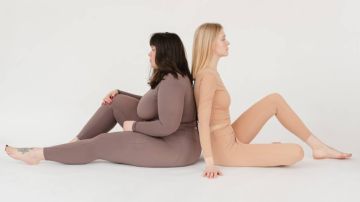The Return of the Thin Body Ideal & its Negative Impact on BIPOC Women
Krista Linares is a registered dietitian nutritionist and founder of Nutrition Con Sabor

Photo: Pexels/ SHVETS productio
Krista Linares is a registered dietitian nutritionist and founder of Nutrition Con Sabor.
We’ve seen it coming for a while now: with the resurgence of 90s and early 2000s fashion trends, the beauty standards of this era are back, too. While millennials have groaned jokingly about never going back to over-plucked eyebrows or low-rise jeans, what has gone a little more unspoken is the fear of the thin body ideal enforced by clothing items like micro-minis, low-rise jeans, and super cropped tops.
But in early November a New York Post article caused waves by saying the quiet part out loud, declaring “Heroin Chic is Back.” It cites the trends seen on fashion runways, as well as noted weight loss (and discussion of weight loss) among celebrities like the Kardashians, who had originally helped drive the wave of curvier figures.
While we come to expect that clothing will come in and out of fashion, it can be jarring to realize the same thing happens with body types. While there’s no one body type that has always been the most popular (curvier bodies were idealized in the Renaissance, for example), several factors converged in the 17th and 18th centuries to create a thin ideal that persisted more or less for centuries.
It was around the 16th and 17th centuries that Europeans began to view race (as opposed to other intergroup differences such as religion) as a way to explain fundamental differences between people and justify social stratification, enslavement, and colonization. It was at this time that larger, curvier bodies began to be associated with Black and Brown women.
At the same time, specific movements in Christianity (Puritanism, for example) rose to prominence with their focus on self-denial as a path to morality and religious enlightenment. Larger bodies, according to this worldview, would have been associated with the sin of gluttony.
These ideas persist today not just in body ideals but also in how we view our cultural foods. Because of the view of Black and Brown bodies as being more sexualized and more “sinful,” this also affected the view of the foods eaten by those communities. Authors Rebecca Earle and Sophie Coe explain how Latinx foods have often been described as immoral (in the case of chiles) or even antithetical to Christianity, as was the case when early Spanish colonizers witnessed how maize was at times used in religious practices. We see echoes of this today when we see stereotypical depictions of our food as “heavy” “greasy” and “unhealthy.”
And it wasn’t just gluttony. Larger bodies were sexualized and thus associated with sinfulness in this way, as well. In her book Fearing the Black Body, author Sabring Strings ties these forces to the association of thin, white bodies with moral goodness and national identity. And thus the thin white ideal took hold.
While there have been different beauty and body ideals since then–compare fashion images from the 1920s to those of the 1950s, for example–it has all usually been under the umbrella of the thin, white ideal. However it was in the 1990s that this ideal took its most extreme form and the ultra-thin look of models like Kate Moss became the ideal. Starting around the mid-2000s the pendulum started to swing in the other direction and curvier bodies, began to be idealized (albeit still with impossible standards like a tiny waist to go along with the curves).
While some people viewed this as a healthier body ideal than the 90s, these body ideals still came with dangerous attempts at bodily control including disordered eating and risky cosmetic procedures like the Brazilian Butt Lift–one of the most dangerous cosmetic procedures with the highest risk of death. And now, the return of the thin ideal is coming at a time when eating disorders were already increasing. Eating disorders have been on the rise since the early 2000s, overall. On top of that, during the COVID-19 pandemic hospitalizations for eating disorders increased by 48 percent.
Use of diabetic medications for weight loss is also on the rise, with medications like Ozempic even seeing shortages due to the demand, making it harder for patients with diabetes to access their medication. What’s more, these medications are not risk free and can cause severe nausea, vomiting, and diarrhea. It’s scary to see the increase in disordered eating and risky use of medications that comes along with these shifting body ideals.
These negative outcomes also disproportionately affect Black and Brown women. Eating disorder treatment is often not equitable, with BIPOC being screened less for eating disorders and less likely to receive treatment. Black women and Latinas are also more likely to exhibit bulimic behaviors, such as bingeing and purging, than white women. In addition to the psychological distress caused by these conditions, they also carry long term health consequences such as dental issues and higher risk of type 2 diabetes.
The imposition of impossible body standards on women is not new. And these body standards disproportionately impacting BIPOC is also not new. Black and Brown women’s bodies have long been the most scrutinized in society, and they have felt the most pressure to conform to white ideals to succeed or gain respect. The fact that BIPOC face the highest consequences of these trends, then, is unsurprising.
For many, the last 10 years felt like a respite from the thin ideal, although it’s worth noting that this era’s body standards came with similar risks to achieve it. All body trends harm women and are associated with disordered eating, risky cosmetic surgeries, and weight loss drugs. And while we’ve been here before, it’s frustrating and scary to see a retread of the cycle that we know is not only dangerous, but disproportionately harmful to Black and Brown women.

















